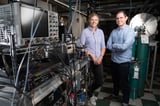Breakthrough: Key Carbon Molecule Detected in Deep Space Sheds Light on Life's Origins
October 24, 2024
The recent discovery of pyrene in the Taurus Molecular Cloud (TMC-1) suggests it may serve as a significant source of carbon for the solar system, providing compelling evidence of molecular inheritance from interstellar clouds.
Researchers detected a modified version of pyrene, known as cyanopyrene, using the Green Bank Telescope, which focuses on observing molecular fingerprints in space.
The finding was unexpected, as pyrene was discovered in an extremely cold environment of only 10 Kelvin, challenging previous assumptions that polycyclic aromatic hydrocarbons (PAHs) form only at higher temperatures.
Cyanopyrene constitutes about 0.1% of the carbon in TMC-1, indicating its notable abundance among various carbon-containing molecules.
This discovery was facilitated by a collaboration between the Hubble and Spitzer telescopes, predecessors to the James Webb Space Telescope.
The study was funded by various organizations, including the National Science Foundation and NASA, showcasing a collaborative effort to advance our understanding of space chemistry.
This research implies that the conditions necessary for forming life on Earth may not be unique, suggesting a common occurrence of such conditions throughout the universe.
Ewine van Dishoeck from Leiden Observatory emphasized the significance of this discovery for understanding carbon chemistry in space, noting that a large fraction of carbon is stored in PAHs.
The findings support the hypothesis that complex organic molecules necessary for life could survive the harsh conditions leading to star and solar system formation.
Brett McGuire, an assistant professor at MIT, highlighted the importance of linking early molecular clouds to the solar system's chemical inventory, indicating strong evidence of molecular inheritance.
The detection utilized the Green Bank Telescope's ability to capture molecular signals based on their rotational spectra, which is crucial for identifying molecules in space.
The findings were published in the journal Science, with Brett McGuire and Ilsa Cooke serving as senior authors and Gabi Wenzel as the lead author.
Summary based on 10 sources
Get a daily email with more Science stories
Sources

ScienceDaily • Oct 24, 2024
Scientists discover molecules that store much of the carbon in space
MIT News | Massachusetts Institute of Technology • Oct 24, 2024
Scientists discover molecules that store much of the carbon in space
ScienceAlert • Oct 25, 2024
Astronomers Discover Complex Carbon Molecules in Interstellar Space